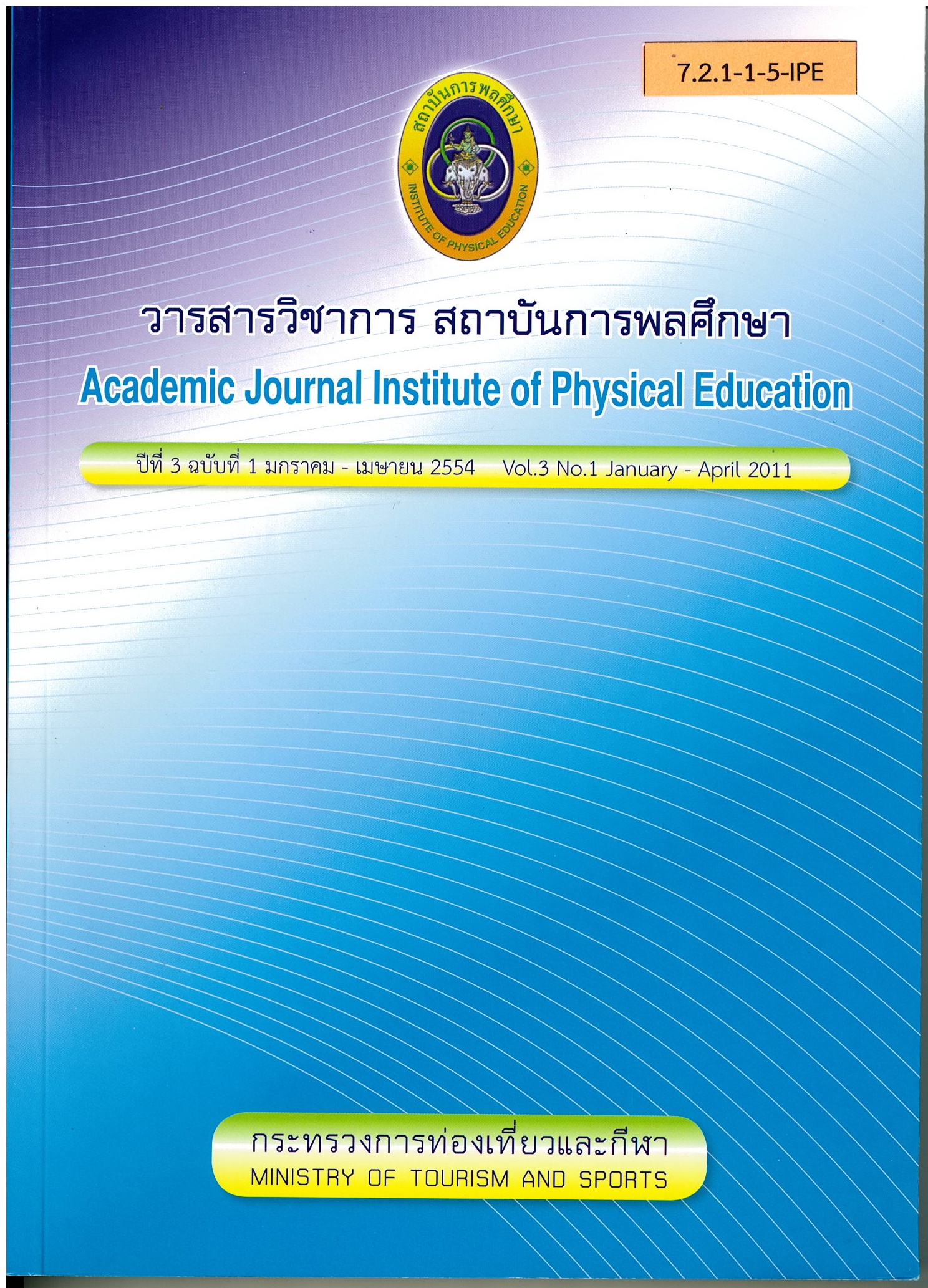ผลของกิจกรรมสี่แบบที่มีต่อการฟื้นตัวในระยะเวลาจํากัด
Main Article Content
บทคัดย่อ
การวิจัยครั้งนี้มีวัตถุประสงค์เพื่อศึกษาและเปรียบเทียบผลของกิจกรรมสี่แบบที่มีต่อ การฟื้นตัวใน ระยะเวลาจํากัด กลุ่มตัวอย่างเป็นนักกีฬาฟุตบอลของทีม สพล.กรุงเทพ - สนั่นรักษ์ เพศชาย จํานวน 20 คน ได้มาโดยการเลือกแบบเฉพาะเจาะจง (Purposive Sampling) ทําการทดลองทั้งสิ้น 4 วัน ซึ่งแต่ละวัน มีระยะเวลาห่างกัน 48 ชั่วโมง
ก่อนทําการทดลอง ให้กลุ่มตัวอย่างทําการชั่งน้ําหนักตัว อบอุ่นร่างกาย 15 นาที นั่งพัก 5 นาที จากนั้นทําการทดสอบ Running - based Anaerobic Sprint Test (RAST) ครั้งที่ 1 เพื่อ หาค่าพลังอนากาศนิยมและค่าสมรรถภาพอนากาศนิยม ภายหลังการทดสอบทําการแบ่งกลุ่มตัวอย่างเพื่อ ทําการฟื้นตัว เป็นเวลา 60 วินาที ด้วยวิธีการที่แตกต่างกันทั้ง 4 แบบ คือ การนั่ง การเดิน การยืดเหยียด กล้ามเนื้อ และการประคบด้วยความเย็น จากนั้นทําการทดสอบ RAST ครั้งที่ 2
นําผลที่ได้มาวิเคราะห์ข้อมูลทางสถิติวิเคราะห์ความแปรปรวนแบบวัดมิติเดียว (One Way ANOVA with Repeated Measure) โดยมีค่านัยสําคัญทางสถิติที่ ระดับ .05 ทําการ เปรียบเทียบรายคู่ด้วยวิธีของบอนเฟอโรนี (Bonferroni) ผลการวิจัยพบว่า
- การฟื้นตัวของค่าพลังอนากาศนิยมระหว่างกิจกรรมทั้ง 4 แบบ ไม่มีความแตกต่างกันอย่างมีนัย สําคัญทางสถิติที่ระดับ .05
- การฟื้นตัวของค่าสมรรถภาพอนากาศนิยมระหว่างกิจกรรมทั้ง 4 แบบ มีความแตกต่างกันอย่าง มีนัยสําคัญทางสถิติที่ระดับ .05
จากผลการวิจัยในครั้งนี้ พบว่าผลการฟื้นตัวของกิจกรรมสี่แบบในด้านพลังอนากาศ นิยมนั้น ไม่ แตกต่างกันแต่ถ้าพิจารณาจากเปอร์เซ็นต์ในการฟื้นตัวพบว่า การฟื้นตัวโดยวิธีการเดินมีแนวโน้มการฟื้น ตัวดีที่สุด ส่วนการฟื้นตัวของกิจกรรมสี่แบบในด้านสมรรถภาพอนากาศนิยมนั้นมีความแตกต่างกัน ซึ่งการ ฟื้นตัวโดยวิธีการเดินนั้นให้ผลในการฟื้นตัวได้ดีที่สุด ดังนั้นนักกีฬาหรือ ผู้ฝึกสอนจึงควรนําวิธีการดังกล่าว ไปประยุกต์ใช้ให้เหมาะสมต่อการฟื้นตัวขณะฝึกซ้อมหรือแข่งขันที่มีช่วงพักสั้นๆ โดยเฉพาะในกีฬาที่ต้องใช้ ความสามารถในด้าน พลังระเบิด หรือความเร็วแบบอดทน
Article Details
บทความที่ได้รับการตีพิมพ์เป็นลิขสิทธิ์ของวารสารวิชาการ มหาวิทยาลัยการกีฬาแห่งชาติ ข้อความที่ปรากฏในบทความแต่ละเรื่องในวารสารวิชาการเล่มนี้ เป็นความคิดเห็นส่วนตัวของผู้เขียนแต่ละท่านไม่เกี่ยวข้องกับวารสารวิชาการมหาวิทยาลัยการกีฬาแห่งชาติ แต่อย่างใด ความรับผิดชอบองค์ประกอบทั้งหมดของบทความแต่ละเรื่องเป็นของผู้เขียนแต่ละท่าน หากมีความผิดพลาดใดๆ ผู้เขียนแต่ละท่านจะรับผิดชอบบทความของตนเองแต่ผู้เดียว
เอกสารอ้างอิง
กวิน พิกุลงาม. (2550). ผลการฟื้นตัวแบบมีกิจกรรมการเคลื่อนไหวที่ระดับความหนักต่างกันที่มีต่อค่าสมรรถภาพอนากาศนิยม, ปริญญานิพนธ์ วท.ม. (วิทยาศาสตร์การกีฬา), กรุงเทพฯ: บัณฑิตวิทยาลัย มหาวิทยาลัยเกษตรศาสตร์.
กันยา ปาละวิวัธน์. (2532). คู่มือรักษาตนเองเรื่องรักษาด้วยความร้อนและความเย็น. กรุงเทพฯ: สํานักพิมพ์หมอชาวบ้าน.
ชูศักดิ์ เวชแพศย์ และกันยา ปาละวิวัธน์. (2536). พิมพ์ครั้งที่ 4. สรีรวิทยาของการออกกําลังกาย. กรุงเทพฯ: ธรรกมลการพิมพ์.
ประทุม ม่วงมี. (2527). รากฐานทางสรีรวิทยาของการออกกําลังกายและทางพลศึกษา. กรุงเทพฯ: บูรพาสาส์น.
พิชิต ภูติจันทร์. (2535). สรีรวิทยาการออกกําลังกาย. พิมพ์ครั้งที่ 2. กรุงเทพฯ: โอเดียนสโตร์.
สนธยา สีละมาด. (2551). หลักการฝึกกีฬาสําหรับผู้ฝึกสอนกีฬา. พิมพ์ครั้งที่ 3. กรุงเทพฯ: สํานักพิมพ์แห่งจุฬาลงกรณ์มหาวิทยาลัย.
สุรัสวดี มรรควัลย์. (2553). สืบค้นเมื่อ 27 กันยายน 2553 จาก http://www.home.kku.ac.th/surmac/surussawadi49/word-study.../10.doc
อําพร ศรียาภัย. (2544). ผลของการพัก การยืดเหยียดกล้ามเนื้อแบบอยู่กับที่ และการซาวน่า ที่มีต่อระดับกรดแลคติกในเลือด และอัตราการเต้นของหัวใจภายหลังการออกกําลังกาย, ปริญญานิพนธ์ วท.ม. (วิทยาศาสตร์การกีฬา), กรุงเทพฯ: บัณฑิตวิทยาลัย มหาวิทยาลัยเกษตรศาสตร์.
Alter, M.J. (1996). Science of Flexibility. 2nd ed. Human Kinetic, United States of America. Amussen, F. and L. Mazin. (1978). Recuperation after muscular fatigue by diverting activities. Eur. J. Appl. Physiol. 38: 1 - 8.
Fox, E. L. & Mathews. D. K. (1981). The Physiological Basis of Physical Education and Athletics (Eds.) p.258. Philadelphia: Saunders College Publishing.
Gupta, S.A. et al. (1996). Comparative study of lactate removal in shot term massage of extremities, active recovery and a passive recovery period after supramaximal exercise season. Journal of sport Medicine. 106 - 110.
Juel, C. (1997). Lactate - proton cotransport in skeletal muscle. Journal of Physiol. Rev. 77: 321 - 358 RAST. (2009). สืบค้นเมื่อ 8 ธันวาคม 2552. จาก http://www.brianmac.co.uk/rast.htm


